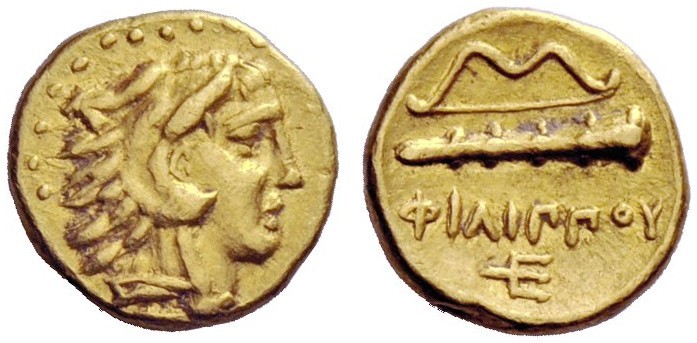Pella (Philip II and Alexander the Great), gold, 1/4 staters (345-310 BCE)
From SILVER
345 BCE - 310 BCE Gold 15,476 kg
Description
| ObverseInscription or printing placed on the obverse.: | Head of Heracles right, wearing Nemean lion skin headdress. |
| ReverseInscription or printing placed on the reverse.: | ΦΙΛΙΠΠΟΥ (Greek).Club and bow. In field, trident. |
Mint and issuing power
| MintIdentifies the place of manufacture or issue of a numismatic object.: | Pella | Ancient regionAncient region.: | Macedon | Modern countryModern country: Greece | AuthorityIdentifies the issuing power. The authority can be "pretended" when the name or the portrait of X is on the coin but he/she was not the issuing power. It can also be "uncertain" when there is no mention of X on the coin but he/she was the issuing power according to the historical sources: | Macedonian kingdom, Philip II (Argead king, 359-336 BC), Alexander III the Great (Argead king, 336-323 BC) |
Chronology
| FromIdentifies the initial date in a range assigned in a numismatic context. | 345 BCE | toIdentifies the final date in a range assigned in a numismatic context.. | 310 BCE | PeriodTime period of the numismatic object.: Classical and Hellenistic |
Physical description
| MetalThe physical material (usually metal) from which an object is made.: | Gold |
Median weightMedian of the weights of numismatic objects (in grams). in grams | 2.15 | DenominationTerm indicating the value of a numismatic object. Examples: tetradrachm, chalkous, denarius.: | tetarte |
StandardStandard.: | Attic |
Image

H103 Herakles Pella.jpeg [1]
References
| Die study referencePublication of the study: | Le Rider 19771Le Rider 1977, p. 233 n° 1-2, 238-244 n° 47-88, 248-250 n° 122-131. | ||
| Coin series referenceReference to coin series study: | RQEMH2RQEMH, n° 103 | ||
| Coin series web referenceCoin series web references: | |||
Obverse dies distribution
| FrequencyFrequency of specimen in distribution. ᵖ | Number of obversesNumber of obverse dies. ᵖ (o) | % (o) | Number of coinsNumber of coins. (n) | % (n) | Die nameName(s) of the die(s). |
| 1 | 10 | 30.3 | 10 | 5.46 | 1, 35, 40, 48, 50, 52, 54, 55, 80, 85 |
| 2 | 1 | 3.03 | 2 | 1.09 | 49 |
| 3 | 5 | 15.15 | 15 | 8.2 | 37, 39, 53, 81, 84 |
| 4 | 2 | 6.06 | 8 | 4.37 | 47, 82 |
| 5 | 2 | 6.06 | 10 | 5.46 | 42, 46 |
| 6 | 2 | 6.06 | 12 | 6.56 | 2, 86 |
| 7 | 3 | 9.09 | 21 | 11.48 | 44, 45, 51 |
| 8 | 1 | 3.03 | 8 | 4.37 | 38 |
| 9 | 1 | 3.03 | 9 | 4.92 | 41 |
| 10 | 1 | 3.03 | 10 | 5.46 | 36 |
| 12 | 1 | 3.03 | 12 | 6.56 | 33 |
| 14 | 1 | 3.03 | 14 | 7.65 | 34 |
| 16 | 1 | 3.03 | 16 | 8.74 | 32 |
| 17 | 1 | 3.03 | 17 | 9.29 | 43 |
| 19 | 1 | 3.03 | 19 | 10.38 | 83 |
| Total | 33 of 33 | 99.99 | 183 of 183 | 99.99 |
Reverse dies distribution
no distribution is available
Quantification
| Number of obversesNumber of obverse dies. ᵖ (o) | 33 | Number of singletons (o1)The number of singleton coins. ᵖ | 10 |
| Number of reverse diesNumber of reverse dies. (r) | 24 | Number of coinsNumber of coins. (n) | 183 |
| Coins per obverse dieNumber of coins per obverse die. (n/o) | 5.55 | Coins per reverse dieNumber of coins per reverse die. (n/r) | 7.63 |
| Reverse per obverse ratioRatio of obverse dies divided by reverse dies. (r/o) | 0.73 | Percentage of singletons (o1)number of coins (n) divided by the number of singletons (o1) ᵖ | 30.3 % |
| Original number of dies (O) (Carter 1983 formula)The estimation of the number of coins according to Carter 1983 ᵖ | 35.99 | Coins struck if 20,000 as average productivity per dieCoins made if the average productivity for obverses (according to Carter) is 20,000. ᵖ | 719,800 |
| Original number of dies (O) (Esty 2011 formula)The estimation of the number of coins according to the singleton formula in Esty 2011 ᵖ (O) | 40.26 | Survival rate if 20,000 as average productivity per dieSurvival rate if average productivity is 20,000. ᵖ | 0.00025 |
| Coverage (o = % of O) (Esty 1984 formula)Esty 1984 - coverage (% of O) ᵖ (o = % of O) | 94.54% | Die productivity if survival rate 1/2,000Average productivity if survival rate is 1/2,000. ᵖ | 10,169.49 |
| Weight of silver (in kg) if 20,000 coins per die (O = Carter formula)Carter 1983 * Median weight * 20000 (*10 if gold or electrum) ᵖ | 15,476 kg <br /> 15,476 kg | Die productivity if survival rate 1/5,000Average productivity if survival rate is 1/5,000. ᵖ | 25,423.73 |
Remarks
Most likely two workstations Certainly military